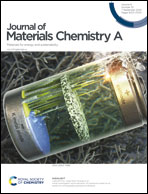Lithium oxidation and electrolyte decomposition at Li-metal/liquid electrolyte interfaces†
Abstract
We examine the evolution of events occurring when a Li metal surface is in contact with a 2 M solution of a Li salt in a solvent or mixture of solvents, via classical molecular dynamics simulations with a reactive force field allowing bond breaking and bond forming. The main events include Li oxidation and electrolyte reduction along with expansion of the Li surface layers forming a porous phase that is the basis for the formation of the solid-electrolyte interphase (SEI) components. Nucleation of the main SEI components (LiF, Li oxides, and some organics) is characterized. The analysis clearly reveals the details of these physical–chemical events as a function of time, during 20 nanoseconds. The effects of the chemistry of the electrolyte on Li oxidation and dissolution in the liquid electrolyte, and SEI nucleation and structure are identified by testing two salts: LiPF6 and LiCF3SO3, and various solvents including ethers and carbonates and mixtures of them. The kinetics and thermodynamics of Li6F, the core nuclei in the LiF crystal, are studied by analysis of the MD trajectories, and via density functional theory calculations respectively. The SEI formed in this computational experiment is the “native” film that would form upon contact of the Li foil with the liquid electrolyte. As such, this work is the first in a series of computational experiments that will help elucidate the intricate interphase layer formed during battery cycling using metal anodes.



 Please wait while we load your content...
Please wait while we load your content...